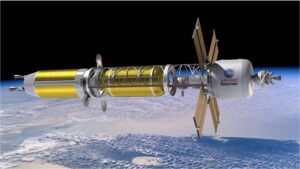Administration policies seek to promote use of space nuclear power

CHANTILLY, Va. — A revised policy for approving the launch of spacecraft with nuclear power systems is the latest measure intended to support greater use of nuclear power systems in orbit and beyond.
The policy, formally issued by President Trump Aug. 20 to coincide with the latest public meeting of the National Space Council, updates guidelines for how both government and commercial spacecraft carrying space nuclear systems are reviewed and approved for launch.
The policy establishes a three-tier system for reviewing payloads carrying nuclear power systems, such as radioisotope thermoelectric generators (RTGs) or fission reactors, based on the amount of radioactive material on board and the probability of certain radiation exposure levels in the event of an accident.
Spacecraft that fall in the first two tiers will be approved by their sponsoring agency, although in some cases with a review by a new Interagency Nuclear Safety Review Board that NASA is tasked to establish within 180 days. Those in the third tier require presidential authorization, which can be done through the National Security Council for national security missions or Office of Science and Technology Policy (OSTP) for other missions.
“Our primary objective here is to ensure that rigorous and effective nuclear safety analysis and reviews are conducted prior to the launch of any space nuclear system,” said Kelvin Droegemeier, director of OSTP, during comments at the National Space Council meeting at the National Air and Space Museum’s Udvar-Hazy Center here. “To that end, we must provide clear guidelines to help mission planners and launch approval authorities ensure that launch safety is maintained.”
The policy, he continued, is also intended to promote a “positive safety analysis” and “forward-looking” authorization process that can take into announce new space nuclear systems.
Droegemeier said the policy was just one step in supporting greater use of space nuclear systems. “Moving forward, we must also focus on ensuring that we sustain the skills here in America and also develop the technologies needed to provide space nuclear systems that are ready to propel as well as power future American spacecraft,” he said.
While the policy doesn’t go into technology development and related issues, it does call on the Secretary of Transportation to develop in the next year guidance for private organizations proposing to launch a vehicle with a space nuclear system. That guidance would explain the licensing and review process for such systems.
However, there’s been little commercial interest in space nuclear power, given not just the regulatory challenges but also technical and cost issues. One startup, Denver-based Atomos Space, has proposed developing nuclear-powered space tugs for in-space transportation, although the company plans to start with solar electric systems and hasn’t specified when it will attempt to fly nuclear-powered systems.
There’s also been few applications of space nuclear power systems on government missions, at least in the unclassified realm. NASA does use RTGs on some missions, but infrequently due to both the cost and limited supplies of plutonium-238, the isotope used in RTGs. The only upcoming NASA missions formally approved for development that will use RTGs are the Mars 2020 rover mission and the recently selected Dragonfly mission to Saturn’s moon Titan.
That could change in the next several years. NASA has been working with the Department of Energy on a small nuclear fission reactor called Kilopower that could be used on future moon and Mars missions. Congress has also increased funding for nuclear thermal propulsion work at NASA, including a provision in the report accompanying the fiscal year 2019 appropriations bill calling for a flight demonstration of a nuclear propulsion system by 2024.
During a panel discussion at the council meeting, Rex Geveden, president and chief executive of BWX Technologies and a former NASA associate administrator, backed the development of more ambitious space nuclear power systems, citing his company’s decades of experience with nuclear power systems, including NASA-funded nuclear thermal propulsion work.
“America has the nuclear technological capabilities right now to push the boundaries of human exploration at the moon and further on to Mars,” he said. “If we to fulfill the objectives of President Trump’s first space policy directive to establish a long-term presence on the moon and send the first crewed mission to Mars, nuclear power is arguably the most important technology to enable these bold national goals.”
NASA Administrator Jim Bridenstine endorsed greater use of nuclear power and propulsion technologies. “That is absolutely a game-changer,” he said of nuclear thermal propulsion. “That gives us the opportunity to, really, protect life” by limiting the cosmic radiation exposure astronauts would receive on long-duration flights, like transits to and from Mars.
Geveden told Bridenstine during a brief discussion at the meeting that space nuclear power could also be used in “a variety of national security applications,” such for remote bases or for directed energy weapons.
“That directed energy weapon, could that be used, for example, to protect the Earth from an asteroid?” Bridenstine asked.
“I think you could envision that,” Geveden responded, adding that such systems could also be used to remove orbital debris.
“I think, Mr. Vice President,” Bridenstine said to Vice President Mike Pence, “there’s an amazing opportunity here that the United States of America should take advantage of.”
from SpaceNews.com https://ift.tt/2Hn87mL
Comments
Post a Comment